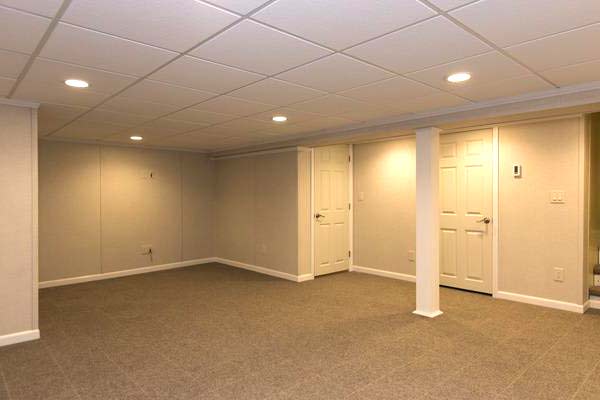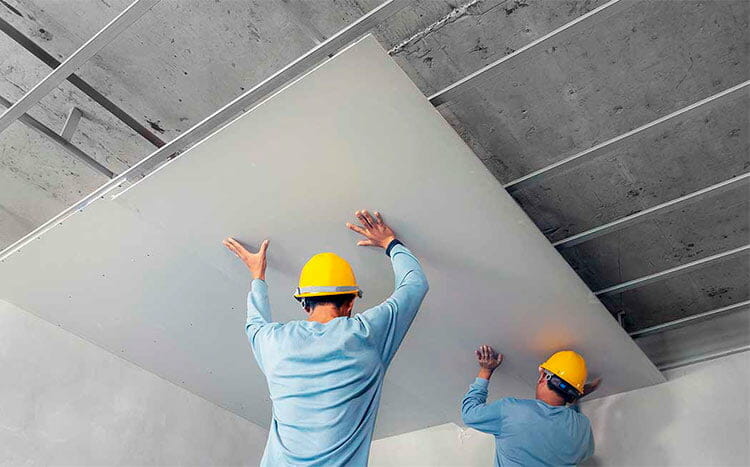When you feel prepared to start finishing your basement, choosing the appropriate ceiling material can frequently cause a surge of concern in your mind.
Both drop ceilings and drywall are good options for finishing a basement, and of course, both of them have pros and cons.
Let’s go together through all the aspects of both materials so that you have a better idea of which one is best for your house.

What we cover
ToggleThe difference between the drop ceiling and drywall ceiling
A drop ceiling, also known as a suspended ceiling, is a grid system that holds tiles together on the ceiling. On the other hand, drywall ceilings are pieces of sheetrock that are screwed, tapped, and mudded to achieve a smooth texture.
Pros and cons of drop ceilings
Pros
Easy access
Drop ceiling provides easy access after installation if there is a need to do some fixes on your wiring for example. With a drop ceiling, you can get in there any time without hesitation, just pop out the tile. With a drywall ceiling, you have to be 100% sure that everything is in the right place before closing up the ceiling.
Easy repairing
In case of water damage, the drop ceiling is very easy to fix and repair. Just simply remove the damaged tile and replace it with new. One of the easiest DIY repairs ever. Easy access to pipes can help you fix the problem if water starts to run in the basement from upstairs.
Cool looking
Drop ceiling has a really cool look that is pleasing to the eye. Lots of interesting things are available to do with the drop ceilings. The lines and the patterns in the ceiling combined with the right tile can transform your basement into a cool and unique place.
Lightning
Installing lights and changing them is a piece of cake with a drop ceiling. The drop ceiling tiles can be interchanged, so if you don’t like how the lighting is, you can move the tiles around to give you a better lighting setup.
Soundproof
Ceiling tiles are a great way to insulate the sound in the room. Different tiles can have a better acoustical rating to block the sound, great for turning your basement into a movie theatre room or just to decrease the sound of the people that are walking upstairs.
Cons
Deteriorates
Drop ceiling deteriorates much quicker than other options. If there is a leak in the roof, you will quickly notice that the ceiling tile turns brown and there is no way to fix it only to replace the tile with a new one. In addition, the tile will begin to sag over time and have a droopy appearance.
Reduces the height
Since the drop ceiling usually requires 4 to 6 inches below the floor joints to install them if you are dealing with a low basement, these extra inches can make a big difference. Drop ceilings are typically a few inches lower than a drywall ceiling. So if you have a low ceiling in spots, a drop ceiling can be a pain.
Installation
While repairing the drop ceiling is a simple task, installation is a little bit more demanding and can take more time than you think. The systems and steps are all very clear cut for installing a drop ceiling but the process isn’t a fast one. The setup of the install also takes a good amount of time and planning, that’s why even the professionals take a good hour to plan out the install before they start to work. Consider that if you are planning to DIY this project.
Pros and cons of a drywall ceiling

Pros
The look
A nice and smooth drywall ceiling is an enjoyment to everyone’s eye. It blends into the room and gives an easy aesthetic to the room allowing the more prominent features of the room to grab your eye.
Safety features
Drywall can make your area safer in case of a fire. In general, it is a fairly fire-resistant material. Also, many manufacturers add additional processes to make sheets more resistant to fire. In addition to fire, some drywall types are mold and moisture-resistant.
Cost-effective
Drywall is a budget-friendly option to finish the ceiling, and there are options for almost every pocket. Also, the labor cost to drywall the ceiling is reasonable. Another one to the pricey side is that the quality of the boards used for a ceiling isn’t as important as the ones used for covering walls, because the contact with your ceiling is a rare occurrence making damage and dings unlikely.
Polished look
Drywalling your unfinished basement ceiling can make a room look and feel finished. It allows for a clean, painted surface, and gives you an option to hide utility lines in the ceiling. Also, painting a ceiling can make a huge visual impact on space since the drywall is easy to paint and repaint to change up the color or hide flaws.
Cons
Installation
If you DIY you can cut the expenses of the installation to a minimum, you will only need drywall, screws, tape, and mudding.
But that is where the complexity starts. Mudding drywall is an art, and if you get it wrong you will have to see the seams forever. Not to mention lifting up drywall over your shoulders for a few days, which is not funny at all. Even if it is a DIY project, consider hiring a pro to finish the job for you.
Screw pops
Over time the drywall shifts and this can make screws protrude through the drywall and ruin the initial smooth look that you are looking for. While it is an easy fix, it is time-consuming and annoying to look at. If you have extreme temperatures throughout the year, you can end up dealing with them several times over the years.
Lightning
Lightning in a drywall ceiling is permanent. If you are DIYing your basement ceiling, then you want to make sure you have enough lighting and placed it properly before the drywall goes up. Because trying to add more lights after the ceiling is done is a hard thing to do.
Water damage
When you have water damage on a ceiling tile, you just simply change the tile and fix the leak. But with drywall, you have to cut out the whole damaged area, and put in a new piece of drywall.
That includes screwing in it, taping it, mudding it constantly, and repainting it. In the end, you have to hope it looks the same as the rest of the ceiling, which won’t because the paint will be fresher than all around it, and it will take a longer time for it to blend in if it ever does.
Basement finishing hacks
I will give you some tips and hacks on how to finish your basement within your budget frame:
Start small
Don’t waste your whole budget on finishing the entire basement with drywall or drop ceiling. Start with the necessary areas and then use your funds to incorporate some fun features. Adding a wet bar or a big-screen TV, or making aesthetic upgrades with brick or stone can take your finished basement to another level and add resale value.
Creative flooring
Find some luxury vinyl tiles for your basement floor. They are water-resistant and cheaper to install than traditional tiles. For a more industrial look, you can refinish the floor with concrete.
Wake up your inner interior designer
A finished basement is a perfect place to be creative and decorative. Make the area stand out with some unique items from second-hand shops or salvage stores. Sky Lodge, a farmhouse or ultimate football fan zone, you can achieve whatever you want.
Clear the air
Ensure clear and ventilated air for your basement because the musty smell can develop eventually. An air purifier could help, so get one.
Check the local codes
When it comes to the framing, electrical, HVAC, and the related calculations as to combustion air, insulation/fire stopping, and plumbing work, these all must be inspected by local municipalities and building departments in many locations. Consider this before starting the project, so you don’t get stuck with permits later and not be able to finish your job right and on time.













